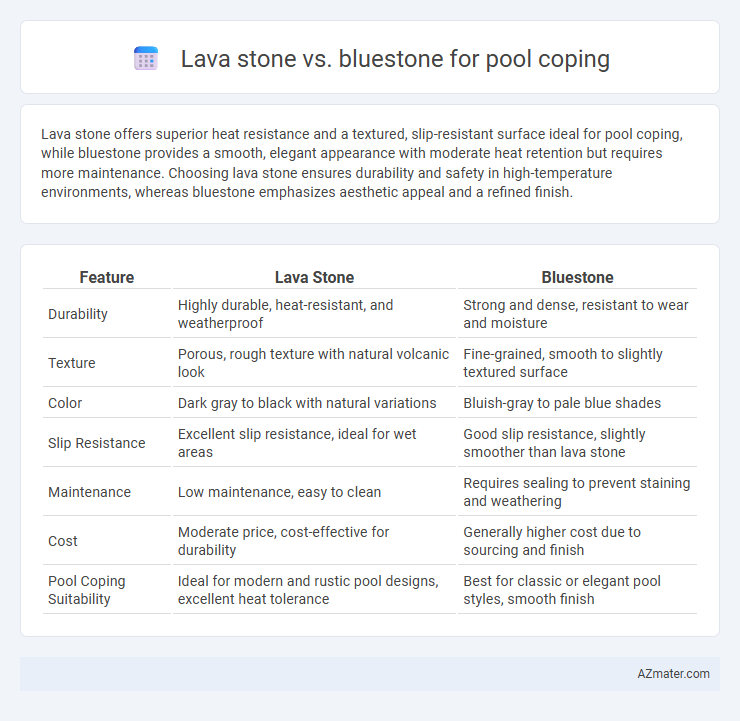Lava stone offers superior heat resistance and a textured, slip-resistant surface ideal for pool coping, while bluestone provides a smooth, elegant appearance with moderate heat retention but requires more maintenance. Choosing lava stone ensures durability and safety in high-temperature environments, whereas bluestone emphasizes aesthetic appeal and a refined finish.
Table of Comparison
| Feature | Lava Stone | Bluestone |
|---|---|---|
| Durability | Highly durable, heat-resistant, and weatherproof | Strong and dense, resistant to wear and moisture |
| Texture | Porous, rough texture with natural volcanic look | Fine-grained, smooth to slightly textured surface |
| Color | Dark gray to black with natural variations | Bluish-gray to pale blue shades |
| Slip Resistance | Excellent slip resistance, ideal for wet areas | Good slip resistance, slightly smoother than lava stone |
| Maintenance | Low maintenance, easy to clean | Requires sealing to prevent staining and weathering |
| Cost | Moderate price, cost-effective for durability | Generally higher cost due to sourcing and finish |
| Pool Coping Suitability | Ideal for modern and rustic pool designs, excellent heat tolerance | Best for classic or elegant pool styles, smooth finish |
Introduction to Pool Coping Materials
Pool coping serves as the protective and decorative edging around a pool, with lava stone and bluestone being popular natural material choices. Lava stone offers excellent heat resistance and a porous texture that provides slip resistance, making it ideal for hot climates and safety-focused pool areas. Bluestone stands out for its dense, fine-grain composition and durability, delivering a sleek, high-end appearance with strong resistance to weathering and wear.
What is Lava Stone?
Lava stone, a volcanic rock formed from cooled molten lava, offers exceptional durability and natural heat resistance, making it an ideal choice for pool coping. Its porous texture provides a non-slip surface that enhances safety around pools while maintaining a unique, rustic aesthetic. Compared to bluestone, lava stone is often lighter and more heat-resistant, reducing heat retention and ensuring cooler, comfortable touch in sunny environments.
What is Bluestone?
Bluestone is a durable, dense natural sandstone prized for its hardness and resistance to weathering, making it ideal for pool coping. It features a smooth, fine-grained texture with a range of colors from blue-gray to greenish hues, enhancing both aesthetic appeal and slip resistance. Unlike lava stone, bluestone offers a more uniform surface that is heat-resistant and easy to maintain around pools.
Aesthetic Differences: Lava Stone vs Bluestone
Lava stone offers a unique, porous texture with rich, earthy tones ranging from deep reds to dark greys, creating a natural, rustic aesthetic perfect for tropical or Mediterranean-inspired pool designs. Bluestone features a smooth, honed surface with subtle blue-grey hues and consistent color variation that imparts a sleek, contemporary look well-suited for modern or minimalist landscapes. The distinctive visual properties of lava stone emphasize organic warmth and rugged charm, while bluestone delivers clean lines and refined elegance for pool coping applications.
Durability and Longevity Comparison
Lava stone exhibits exceptional durability due to its natural volcanic origin, which provides a dense, porous surface resistant to chipping, cracking, and heat damage, making it ideal for pool coping. Bluestone, a dense sandstone variant, offers significant longevity with excellent resistance to weathering and freeze-thaw cycles, but can be more susceptible to surface erosion over time compared to lava stone. For long-term pool coping applications, lava stone generally outperforms bluestone in maintaining structural integrity and minimizing maintenance needs.
Slip Resistance and Safety Features
Lava stone offers exceptional slip resistance due to its porous texture and natural rough surface, making it a safer choice for pool coping in wet conditions. Bluestone, while durable and aesthetically appealing, tends to have a smoother finish that can become slippery when wet, requiring additional treatment to enhance safety. Prioritizing non-slip surfaces and natural grip, lava stone reduces the risk of slips and falls, ensuring greater safety around pool areas.
Heat Retention and Comfort Underfoot
Lava stone features high heat retention, making it warmer underfoot during the day, which can cause discomfort in hot climates, while bluestone remains cooler, providing comfort even in intense sun exposure. Bluestone's dense, non-porous surface absorbs less heat compared to the porous texture of lava stone, resulting in a more comfortable pool coping experience. Choosing bluestone ensures a cooler, safer surface around pools, minimizing heat-related discomfort and burns for barefoot users.
Maintenance Requirements and Care
Lava stone pool coping requires minimal maintenance due to its dense, non-porous surface that resists stains and algae growth, making it ideal for easy cleaning with mild soap and water. Bluestone, while durable, is more porous and needs regular sealing to protect against moisture penetration, staining, and mold buildup, necessitating periodic resealing every 1-2 years. Both materials benefit from routine debris removal and prompt addressing of any surface damage to preserve their aesthetic and functional integrity around pools.
Cost Comparison: Lava Stone vs Bluestone
Lava stone pool coping generally costs between $15 and $25 per square foot, offering a balance of natural durability and affordability. Bluestone tends to be pricier, ranging from $20 to $35 per square foot, reflecting its premium aesthetics and higher density. Budget-conscious projects often favor lava stone for lower initial investment, while bluestone suits those prioritizing long-term value due to its resistance to chipping and weathering.
Which Stone is Best for Your Pool Coping?
Lava stone offers exceptional heat resistance and slip-resistant texture, making it ideal for pool coping in hot climates, while bluestone provides durable, dense properties with a natural, elegant appearance suited for cooler environments. Bluestone's ability to maintain cooler surface temperatures enhances comfort around the pool, whereas lava stone's porous nature allows for better water drainage and quick drying. Choosing between lava stone and bluestone depends on climate, aesthetic preference, and maintenance requirements to ensure optimal safety and longevity for pool coping.

Infographic: Lava stone vs Bluestone for Pool coping
 azmater.com
azmater.com